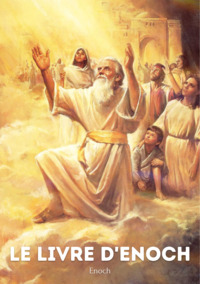Nous utilisons des cookies pour améliorer votre expérience. Pour nous conformer à la nouvelle directive sur la vie privée, nous devons demander votre consentement à l’utilisation de ces cookies. En savoir plus.
The Book of Enoch
EAN : 9782385080891
Édition papier
EAN : 9782385080891
Paru le : 23 oct. 2022
19,99 €
18,95 €
Disponible
Pour connaître votre prix et commander, identifiez-vous
Notre engagement qualité
-
 Livraison gratuite
Livraison gratuite
en France sans minimum
de commande -
 Manquants maintenus
Manquants maintenus
en commande
automatiquement -
 Un interlocuteur
Un interlocuteur
unique pour toutes
vos commandes -
 Toutes les licences
Toutes les licences
numériques du marché
au tarif éditeur -
 Assistance téléphonique
Assistance téléphonique
personalisée sur le
numérique -
 Service client
Service client
Du Lundi au vendredi
de 9h à 18h
- EAN13 : 9782385080891
- Réf. éditeur : 246300
- Date Parution : 23 oct. 2022
- Disponibilite : Disponible
- Barème de remise : NS
- Nombre de pages : 400
- Format : H:210 mm L:148 mm E:21 mm
- Poids : 516gr
- Résumé : The Book of Enoch is an ancient religious text, traditionally ascribed to the Judeo-Christian prophet Enoch, the ancestor of the biblical figure, Noah. Some scholars estimate that some parts of the book vary widely in age from several hundred years before Christ to the last parts in the century before the birth of Jesus. This text is widely considered non-canonical although it is accepted that it is a genuine attempt to record information as best the authors were able in the pre-Christian era. In the text, Enoch is a figure who receives direct personal revelation from God. He sees the magnificence of God and begins to preach to those around him against sin. He warns that the sinners will be winnowed and that God himself will appear on Mount Sinai to judge the humans as well as the fallen angels on Earth. Among the more controversial material within this text is the detailed account it gives of fallen angels on earth and their cursed offspring, the Nephilim. Azazel features heavily as the instigator of metal weapon production, the use of cosmetics and advocate of widespread promiscuity and fornication. In this book, the figure of Enoch is charged with the knowledge of God's chosen and brutal punishment for the Nephilim, their human mothers and their Angel fathers. August Dillman's translation from the Ethiopian is part of his extensive work translating biblical era manuscripts and this particular version is augmented with his observations, Latin excerpts and a stunning foreword by R. H. Charles. One of the most important apocryphic works of the Second Temple Period is Enoch. According to the biblical narrative (Genesis 5:21-24), Enoch lived only 365 years (far less than the other patriarchs in the period before the Flood). Enoch "walked with God; then he was no more for God took him." The original language of most of this work was, in all likelihood, Aramaic (an early Semitic language). Although the original version was lost in antiquity, portions of a Greek translation were discovered in Egypt and quotations were known from the Church Fathers. The discovery of the texts from Qumran Cave 4 has finally provided parts of the Aramaic original. In the fragment exhibited here, humankind is called on to observe how unchanging nature follows God's will. The Book of Enoch is a pseudoepigraphal work (a work that claims to be by a biblical character). The Book of Enoch was not included in either the Hebrew or most Christian biblical canons, but could have been considered a sacred text by the sectarians. The original Aramaic version was lost until the Dead Sea fragments were discovered.
- Biographie : Enoch is a biblical figure and patriarch prior to Noah's flood and the son of Jared and father of Methuselah. He was of the Antediluvian period in the Hebrew Bible. Enoch is the subject of many Jewish and Christian traditions. He was considered the author of the Book of Enoch and also called the scribe of judgment. In the New Testament, Enoch is referenced in the Gospel of Luke, the Epistle to the Hebrews, and in the Epistle of Jude, the last of which also quotes from it. In the Catholic Church, Eastern Orthodoxy, and Oriental Orthodoxy, he is venerated as a saint.











